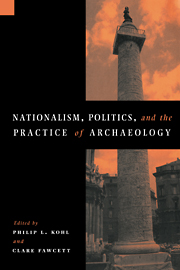Book contents
- Frontmatter
- Contents
- List of maps
- List of contributors
- Acknowledgments
- Part I Introduction
- Part II Western Europe
- Part III Eastern Europe and Eurasia
- 7 Archaeology and ideology in southeast Europe
- 8 From internationalism to nationalism: forgotten pages of Soviet archaeology in the 1930s and 1940s
- 9 Postscript: Russian archaeology after the collapse of the USSR – infrastructural crisis and the resurgence of old and new nationalisms
- 10 Nationalism, politics, and the practice of archaeology in the Caucasus
- Part IV East Asia
- Part V Commentary
- Bibliography
- Index
9 - Postscript: Russian archaeology after the collapse of the USSR – infrastructural crisis and the resurgence of old and new nationalisms
Published online by Cambridge University Press: 06 October 2009
- Frontmatter
- Contents
- List of maps
- List of contributors
- Acknowledgments
- Part I Introduction
- Part II Western Europe
- Part III Eastern Europe and Eurasia
- 7 Archaeology and ideology in southeast Europe
- 8 From internationalism to nationalism: forgotten pages of Soviet archaeology in the 1930s and 1940s
- 9 Postscript: Russian archaeology after the collapse of the USSR – infrastructural crisis and the resurgence of old and new nationalisms
- 10 Nationalism, politics, and the practice of archaeology in the Caucasus
- Part IV East Asia
- Part V Commentary
- Bibliography
- Index
Summary
Archaeology's dependence upon political and economic circumstances is graphically illustrated by recent developments affecting its practice in the former Soviet Union. This brief postscript to Shnirelman's longer historical study first describes the breakdown of state-sponsored support for archaeology and then attempts to explain the recent outbreak of various nationalist archaeologies throughout the former USSR through a consideration of the disguised Russian nationalism of Soviet “Marxist” archaeology. Since the current situation is so volatile, it is worth recording that these remarks were prepared in winter 1994.
The current crisis
The whole centralized system of Soviet (now Russian) science quickly and inexorably began to unravel simultaneously with the advent of perestroika in 1985–6. This disastrous process occurred so suddenly that by 1993–4 only one important question was left for discussion: has the whole infrastructure of the former global Soviet scientific organization already collapsed or is the final dénouement still to come? Obviously, political and economic factors explain this ongoing tragedy. New realities, associated with the break-up of the Soviet empire, have erected severe and sometimes nearly insuperable political barriers among different parts of the huge state-sponsored Academy of Sciences, the organization which for decades provided the complex infrastructure for nearly all scientific research.
Economic factors, however, were far more important. State financing of scientific research, which had been in fact the main source of support for scientific organizations, was cut drastically and, in many cases, completely. Consequently, numerous large scientific projects were implemented slowly or were completely frozen.
- Type
- Chapter
- Information
- Nationalism, Politics and the Practice of Archaeology , pp. 139 - 148Publisher: Cambridge University PressPrint publication year: 1996
- 1
- Cited by



